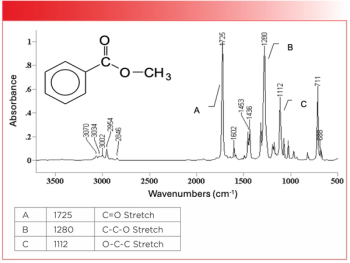
Infrared Spectroscopy Market to Grow 5% to $2 Billion by 2032, New Report Finds
This article recaps a recent study into the infrared (IR) spectroscopy market.
Between 2024 and 2032, the market for infrared spectroscopy is expected to grow 5% to approximately $2 billion USD, according to a new market research report from Global Market Insights (1). In 2023, the global IR spectroscopy market was valued at $1.3 billion (1). According to the report, Fourier-transform infrared (FT-IR) spectroscopy is the leading IR technique, generating approximately 30% of the market share in 2023 (1).
North America continues to claim the largest market share in IR spectroscopy, but other emerging markets in Asia are eating away at North American dominance in this field, the report found. For example, China and Japan are now significant players in the IR spectroscopy industry. Japan is leading in research and development, particularly in pharmaceutical analysis, and as a result, it is using IR spectroscopy technology for drug development and quality assurance initiatives (1). China has made extensive efforts recently to improve environmental monitoring and food safety standards, which has accelerated the demand for IR spectroscopy instrumentation (1).
Infrared (IR) spectroscopy is one of the more popular techniques of choice in analytical spectroscopy. When used effectively, IR spectroscopy can reveal a plentiful amount of information about chemical structures and compositions (2). It works by measuring the absorption of IR radiation by a sample, which causes molecular vibrations such as stretching, bending, or twisting of chemical bonds (2). These vibrations are unique to specific functional groups within a molecule, resulting in a characteristic IR spectrum often referred to as the molecule's "fingerprint” (2).
There are two broad categories of IR spectroscopy: near-infrared (NIR) spectroscopy and Fourier transform infrared (FT-IR) spectroscopy. NIR spectroscopy examines the absorption of NIR light, and it is normally used when rapid, non-destructive analysis is required (2). Because of this, it is often that NIR spectroscopy is used in agriculture and pharmaceutical analysis (2).
FT-IR spectroscopy, meanwhile, is known for its ability to collect spectral data under a wide range (2). FT-IR spectroscopy is also easy for users to learn and is cost-effective (3). FT-IR spectroscopy is also known for having the ability to analyze all materials, whether it is solids, liquids, or gases (3). As a result of these attributes, FT-IR spectroscopy is often used in environmental monitoring and chemical identification (2).
When it comes to IR spectroscopy, it is not only its increased usage in other industries, such as pharmaceutical analysis, environmental analysis, and food and beverage analysis, that is driving the technique forward. Advances in technology have also propelled IR spectroscopy to greater heights over the past couple decades. One of the biggest ongoing trends in the IR spectroscopy industry (and spectroscopy wit and large) is the push for portable and miniaturized spectrometers (4). In most cases, the shrinking of these instruments has only led to small performance reductions in spectral resolution, sampling versatility, and spectral range (4).
These devices have only become more pervasive as scientists have begun to demand their usage industries like environmental monitoring, food safety, and forensic science (1). What also has made these devices popular is that they are user friendly, which allowed non-specialists to use them with minimal training (1).
Experts have also looked to implement artificial intelligence and machine learning to improve data analysis and interpretation (1). IR spectra can be complex, and sorting through the data manually is a time-consuming process. AI and ML have helped analysts identify patterns in the data much more quickly, allowing them to complete their studies more rapidly (1).
In addition, IR spectroscopy is being integrated with other analytical techniques, such as chromatography and mass spectrometry (MS). This approach takes advantage of the strengths of each analytical method, allowing it to conduct a more comprehensive analysis (1).
References
- Global Market Insights, IR Spectroscopy Market Size - By Technology, By Type, By Product Type, By End-use Industry & Forecast, 2024 – 2032. GMInsights.com. Available at:
https://www.gminsights.com/industry-analysis/ir-spectroscopy-market?utm_source=globenewswire.com&utm_medium=referral&utm_campaign=Paid_globenewswire (accessed 2024-11-15). - Excedr, What is Infrared Spectroscopy? Fundamentals & Applications. Excedr.com. Available at:
https://www.excedr.com/blog/what-is-infrared-spectroscopy (accessed 2024-11-15). - Bruker, Applications of Infrared Spectroscopy. Bruker.com. Available at:
https://www.bruker.com/en/products-and-solutions/infrared-and-raman/guide-to-applications-of-ir-spectroscopy.html (accessed 2024-11-15). - Crocombe, R. Spectrometers in Wonderland: Shrinking, Shrinking, Shrinking. Spectroscopy 2022, 37 (s11), 6–11. DOI:
10.56530/spectroscopy.lz8466z5
Newsletter
Get essential updates on the latest spectroscopy technologies, regulatory standards, and best practices—subscribe today to Spectroscopy.





